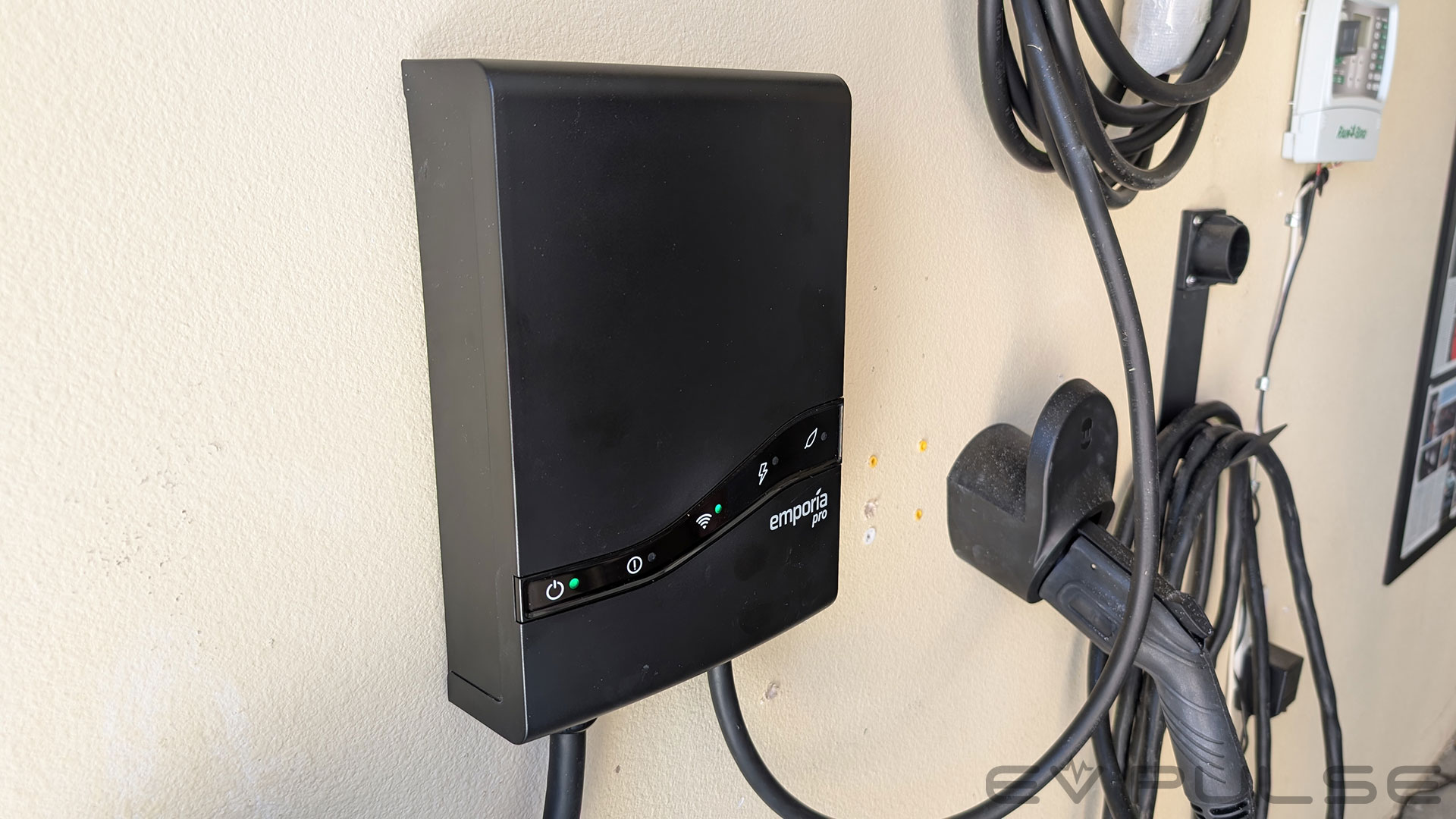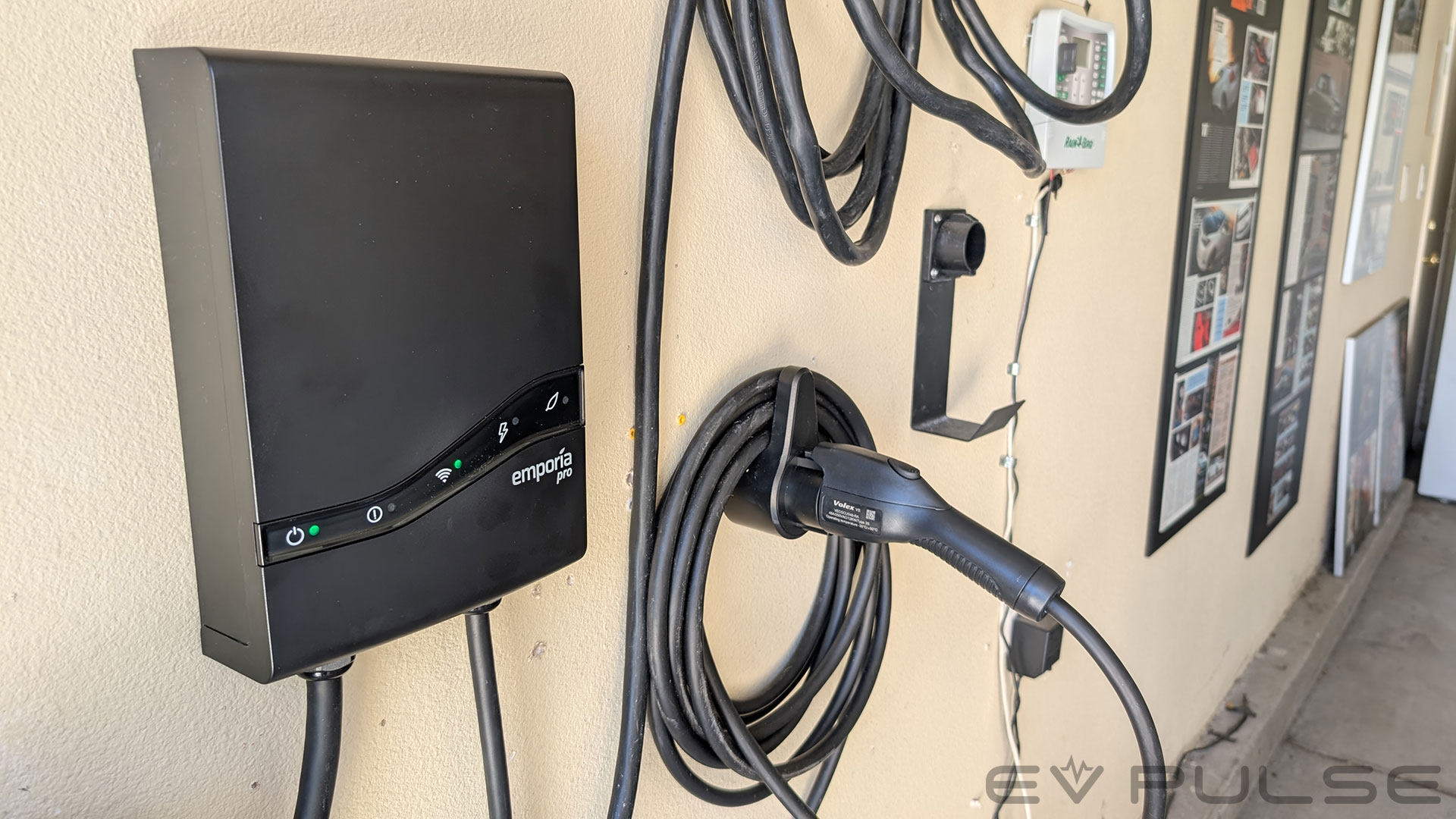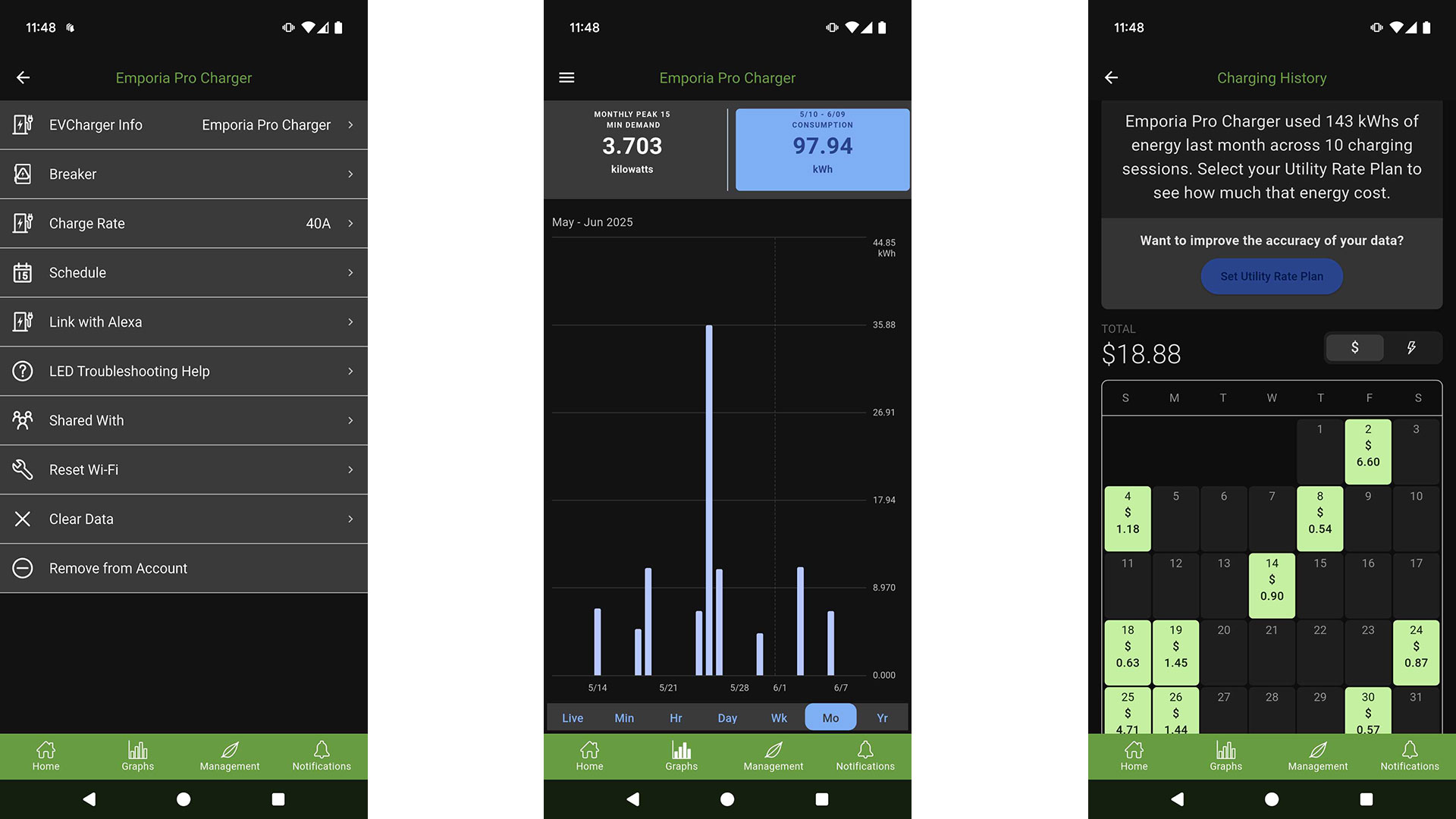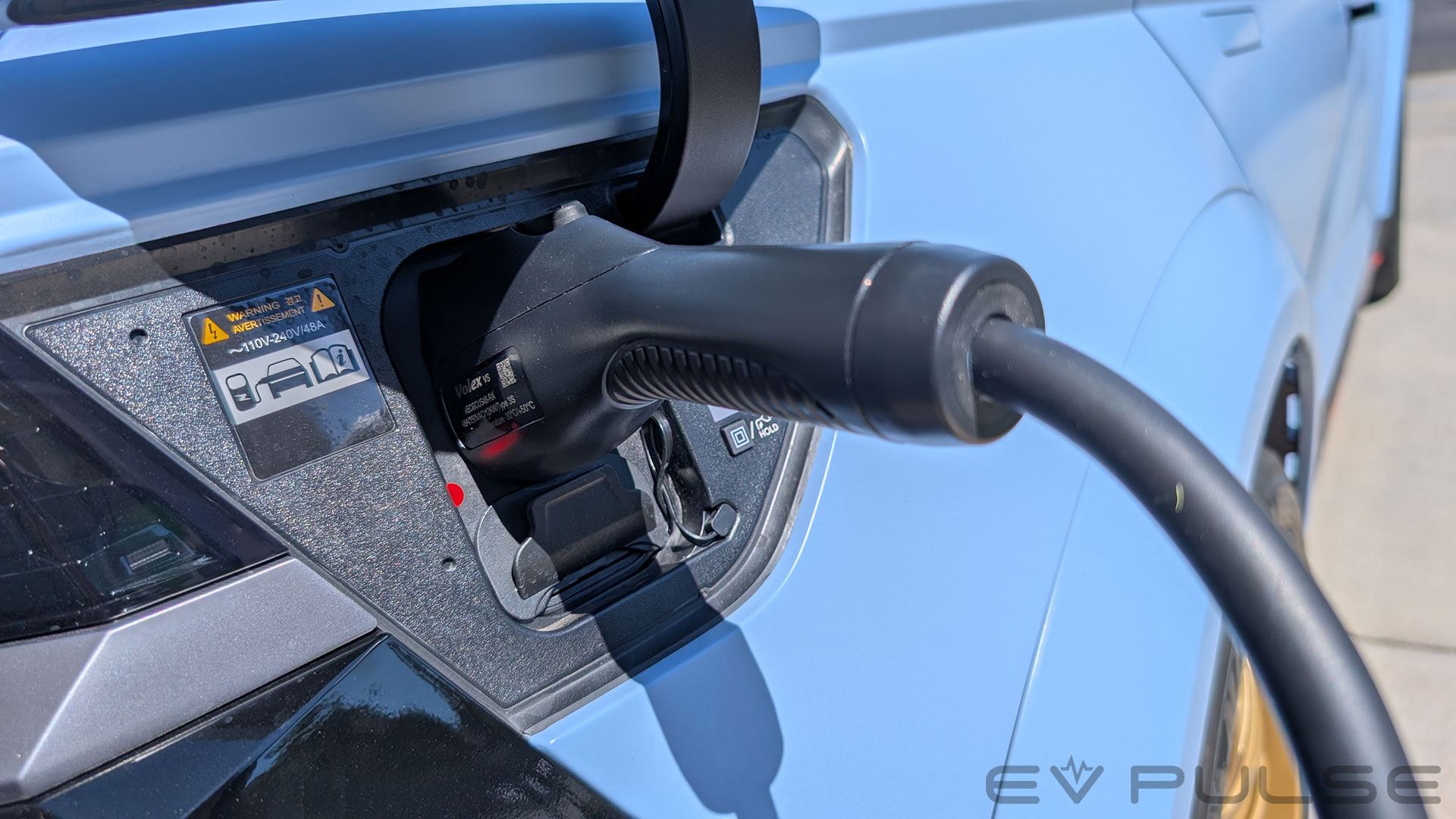In April 2023, we had the opportunity to evaluate Emporia’s Level 2 home EV charger, which is now known as the Classic model. Obviously, the $399 price tag (now $429) caught my interest; at the time, it was half the cost of some competitors while offering a similar list of features. I came away very impressed with the Emporia charger and the company as a whole. Founded in 2018 and based in Colorado, Emporia is an energy company that offers a wide range of products, including home energy monitors.
With its newest offering, the Emporia Pro, the company decided to bundle the home EV charger with the Emporia Vue 3 Home Energy Monitor, complete with a pair of 200a CT sensors. By utilizing PowerSmart, the Emporia Pro gets real-time energy data from the Vue Energy Monitor device, unlocking dynamic load balancing to regulate power to the Emporia Pro EV charger. This way, the charger actually considers the home’s electrical usage to determine the maximum safe power it can use for the charging session. More importantly, the components work together to protect against overloading your home’s electrical system, avoiding power outages and other safety hazards.

The thing is, the Emporia Pro costs $599, so it no longer stands out as an affordable option. That price increase, however, also includes Emporia’s PowerSmart technology, which automatically balances load and may be worth it for many users. For our review, I opted for the plug-in charger with a NEMA 14-50 plug since I already have an outlet installed. The plug-in version has a maximum power output of 9.6 kW (40 amps), while the hardwired variant peaks at 11.5 kW (48 amps). When we requested our review unit, only the J1772 connector was available, but Emporia promises a NACS version is due for Q4 2025.
Like the first Emporia charger we reviewed, the Emporia Pro comes nicely packaged with all components securely fastened and is manufactured in India. Quality continues to earn high marks from me, thanks to a sleek enclosure that houses all the hardware. The front of the charger features five notification lights, so you can get a status update with a quick glance. You must control all charging functions through the Emporia app.

Initial impressions
Installation of the Emporia Pro is very similar to other chargers, with a bracket that needs to be mounted to the wall. Once the bracket is secure, the charger hooks onto it and two screws go in from underneath to secure it. I was very happy to see that Emporia addressed one of my biggest criticisms of its Classic charger’s holster design. The Classic model has a built-in holster on the unit itself, one that I said was one of the worst holster designs I’ve tested. The Emporia Pro comes with a separate holster, which means you can install it wherever you like. I still prefer something that has a bit of an angle so the connector doesn’t protrude straight out from the wall, but this is a vast improvement. The 25-foot charging cable easily wraps around the holder, and I liked how flexible it was. It reminds me a bit of Tesla’s home charger, with its more svelte design. The NEMA 14-50 power cable measures 28 inches.

With a watertight NEMA Type 4 enclosure, the Emporia Pro can be installed indoors or outdoors, and overall I found it to be of great quality. The black model is a bit of a fingerprint magnet, but how often are you touching your EVSE? The overall profile is a bit larger than I’d like—the Wallbox Pulsar Plus continues to be the winner if you want a smaller footprint. The Emporia Pro is a bit on the slimmer side though, if that matters to you.
As for the charging connector, Emporia isn’t keeping it a secret where it comes from. The Volex labeling remains intact, confirming who supplies the charging cable. I’m personally still not a huge fan of the overly plastic connectors, and still prefer a nice rubber texture to prevent slipping. Overall, it’s fine, but I would have preferred to see something more premium in this price range.

How does it work?
Unsurprisingly, the Emporia Pro charger works like a charm. The setup process was one of the quickest I’ve experienced, with the app seemingly cutting out as much bloat as possible. The overall UI design of the app is a bit outdated, but it’s easy to read and lets you access what’s important quickly. I particularly like the Charging History calendar, which breaks down how many kilowatt-hours of energy were used, the number of charging sessions, and an estimate of the cost. You can set a utility rate plan to get more accurate data if that’s important to you.
Since it is a smart charger, the Emporia Pro is capable of scheduling events and can link with Alexa. It’s worth noting that setting the charge rate can only be done through the app, as the unit itself doesn’t have a dial you can set. I have been using the Emporia Pro charger for nearly two months, using it to charge my Hyundai Ioniq 5 N and a Toyota Prius Prime. I haven’t run into a single issue with the charger and it’s been great to see the data in the app after each charging session.

I honestly couldn’t find anything to complain about with the Emporia Pro charger. I like the flexibility of the charging cable, and the separate connector holster addresses one of my biggest issues with the Classic charger. Some users may prefer a physical way to limit the charge rate instead of having to control it from the app, but keep in mind, when the entire package is installed, you should be letting the software dictate how the charge rate is being handled. I would have preferred a different finish to the connector, but it’s a high-quality connector from Volex, so it’ll likely hold up to drops.
As I mentioned earlier though, the Emporia Pro comes at a price premium compared to the company’s Classic charger. At the time of writing, the Emporia Pro has a $599 price tag, while the Classic is $429. The $170 difference gets you Emporia’s Vue 3 Home Energy Monitor, which is a great addition if you plan on taking advantage of dynamic load balancing. Just make sure your panel can accommodate it and that your Wi-Fi signal is strong enough.
Specifications

The Emporia Pro Level 2 home EV charger supports up to 40 amps using a NEMA 14-50 outlet (28 inch cable) or 48 amps when hardwired. The charging cable measures 25 feet and comes with a J1772 connector; a NACS version is coming in late 2025. The package includes Emporia’s Vue 3 Home Energy Monitor with two 200a CT sensors, PowerSmart software, a separate connector holster, and all necessary mounting hardware.
The enclosure is NEMA Type 4–rated, and certifications are plentiful, including NEC 625, SAE J1772, SAE J3400, UL 817, UL 991, UL 2251, and UL 2594.
Verdict

If dynamic load balancing and the features of Emporia’s Vue 3 Home Energy Monitor interest you, then getting the Emporia Pro Level 2 home EV charger is an easy choice. However, if you don’t plan on taking advantage of those features, it’s not an entirely bad idea to save yourself some money and go with the Emporia Classic charger. Both are winners in my eyes. Having used Emporia’s previous charger for over two years, I have a lot of confidence in the brand.
The brand’s app remains one of the best, and unlike some other chargers that have disconnected over time, I haven’t experienced issues like that with Emporia’s units. I plan on giving it another month or two before finding it a spot on our best home EV chargers list, but know it comes highly recommended from me after testing nearly a dozen different home EV chargers over the years.
Emporia includes a three-year warranty with all its chargers as well as a 60-day easy-return window if you purchase directly from them.
- Includes Vue Home Energy Monitor as a unique selling point
- Takes advantage of software to dynamic load balance
- Smart features
- NEMA Type 4 enclosure
- Plenty of certifications
- Flexible 25′ connector cable
- Fantastic app experience
- Three-year warranty
Cons
- Still not a fan of the plastic finish on the connector
- $599 price tag makes it less competitive in the market

